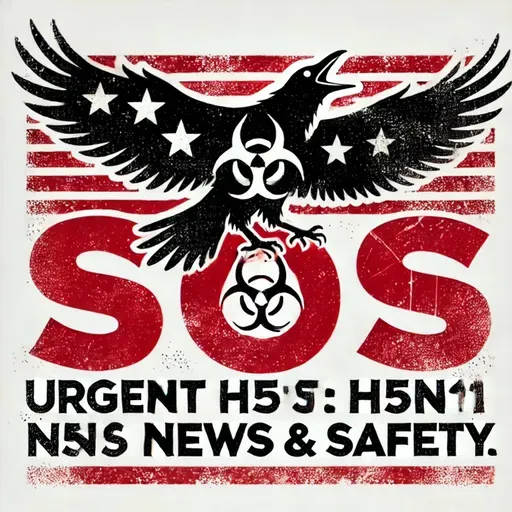
25 August 2025
H5N1 Bird Flu Surge Hits US Dairy Farms Alarming Health Experts with Rapid Spread and Potential Human Transmission Risk
Bird Flu SOS: Urgent H5N1 News & Safety
About
This is Bird Flu SOS: Urgent H5N1 News & Safety. I’m your host, and today—Monday, August 25, 2025—major news has just broken about the aggressive spread of H5N1 bird flu across U.S. dairy farms. According to the California Department of Food and Agriculture, 43 dairy herds in California have tested positive once again after previously clearing quarantine, signaling a powerful resurgence and raising alarms on containment challenges. State authorities have reimposed quarantines and extended bans on all poultry and dairy cattle exhibitions at public events.
Meanwhile, global health agencies are watching closely. According to the CDC and the World Health Organization, bird flu outbreaks have reached unprecedented levels worldwide, with Cambodia reporting 15 human cases already this year, seven of which have been fatal. In the U.S., the CDC confirms 70 human cases since the 2024 outbreak began, nearly all among farm or dairy workers. Weld County, Colorado has become a hot spot—a multi-species outbreak has led to ten human cases and new mandatory surveillance requirements for farms.
Dr. Erik Karlsson, Pasteur Institute Cambodia, warns, "The current pace and severity of infections show how rapidly the H5N1 virus can cross species. Direct contact with sick livestock and poultry remains the critical risk factor." Dr. John Barnes, CDC veterinary epidemiologist, adds, "Most infections in people still result from handling ill poultry or cows. So far, there’s no evidence of person-to-person spread, but the public health threat remains severe for those with direct exposure."
If you live or work in an affected region, immediate steps are critical:
- Avoid all contact with sick or dead birds or livestock. Farm workers must wear gloves, eye protection and N95 masks when handling animals.
- Do not consume unpasteurized raw milk or undercooked eggs from affected regions.
- Farm owners should rigorously disinfect equipment and restrict movement of animals.
- Report any sudden deaths, unexplained animal illness, or clusters of sick birds to local agricultural authorities immediately.
Warning signs that require an emergency response include fever, severe cough, difficulty breathing, sudden vision changes, or unusual fatigue in anyone with livestock or poultry exposure. Human cases in recent outbreaks developed rapidly into respiratory distress, highlighting the need for prompt action.
For emergency assistance, reach out to your local health department, animal control, or call the CDC’s dedicated avian influenza hotline. The USDA maintains state-by-state resources and updates at their website for animal health, and your state’s department of public health can offer human testing and guidance on next steps.
Let’s put this urgency in context. While the CDC currently rates public health risk as low for the general population, the H5N1 bird flu remains a genuine emergency for agriculture communities and anyone in close contact with livestock. Vigilant monitoring, swift quarantine measures, and personal protective equipment remain your first defense.
Stay alert. Monitor official updates. Do not panic—but protect yourself, your family, and your animals with informed action. Thank you for tuning in to Bird Flu SOS. Come back next week for more critical updates. This has been a Quiet Please production. For more, check out Quiet Please Dot A I.
For more http://www.quietplease.ai
Get the best deals https://amzn.to/3ODvOta
Meanwhile, global health agencies are watching closely. According to the CDC and the World Health Organization, bird flu outbreaks have reached unprecedented levels worldwide, with Cambodia reporting 15 human cases already this year, seven of which have been fatal. In the U.S., the CDC confirms 70 human cases since the 2024 outbreak began, nearly all among farm or dairy workers. Weld County, Colorado has become a hot spot—a multi-species outbreak has led to ten human cases and new mandatory surveillance requirements for farms.
Dr. Erik Karlsson, Pasteur Institute Cambodia, warns, "The current pace and severity of infections show how rapidly the H5N1 virus can cross species. Direct contact with sick livestock and poultry remains the critical risk factor." Dr. John Barnes, CDC veterinary epidemiologist, adds, "Most infections in people still result from handling ill poultry or cows. So far, there’s no evidence of person-to-person spread, but the public health threat remains severe for those with direct exposure."
If you live or work in an affected region, immediate steps are critical:
- Avoid all contact with sick or dead birds or livestock. Farm workers must wear gloves, eye protection and N95 masks when handling animals.
- Do not consume unpasteurized raw milk or undercooked eggs from affected regions.
- Farm owners should rigorously disinfect equipment and restrict movement of animals.
- Report any sudden deaths, unexplained animal illness, or clusters of sick birds to local agricultural authorities immediately.
Warning signs that require an emergency response include fever, severe cough, difficulty breathing, sudden vision changes, or unusual fatigue in anyone with livestock or poultry exposure. Human cases in recent outbreaks developed rapidly into respiratory distress, highlighting the need for prompt action.
For emergency assistance, reach out to your local health department, animal control, or call the CDC’s dedicated avian influenza hotline. The USDA maintains state-by-state resources and updates at their website for animal health, and your state’s department of public health can offer human testing and guidance on next steps.
Let’s put this urgency in context. While the CDC currently rates public health risk as low for the general population, the H5N1 bird flu remains a genuine emergency for agriculture communities and anyone in close contact with livestock. Vigilant monitoring, swift quarantine measures, and personal protective equipment remain your first defense.
Stay alert. Monitor official updates. Do not panic—but protect yourself, your family, and your animals with informed action. Thank you for tuning in to Bird Flu SOS. Come back next week for more critical updates. This has been a Quiet Please production. For more, check out Quiet Please Dot A I.
For more http://www.quietplease.ai
Get the best deals https://amzn.to/3ODvOta